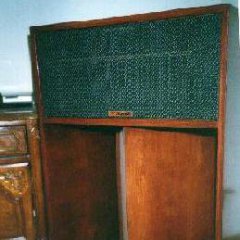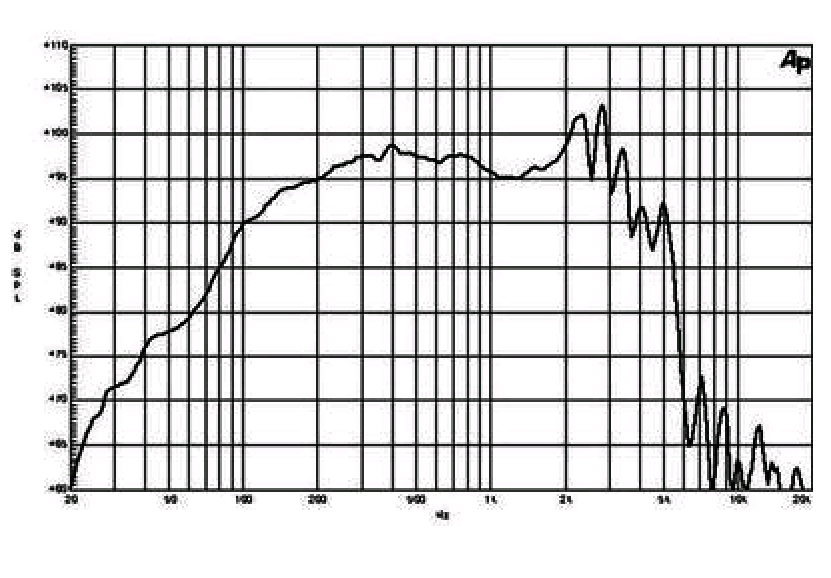-
Posts
5907 -
Joined
-
Last visited
-
Days Won
1
Content Type
Forums
Events
Gallery
Everything posted by JohnA
-
Bonjour! Just about your only option is a Crites CW1228 Woofer. I am pretty sure the K-31 has been discontinued. https://critesspeakers.com/prices-other_stuff.html You can also try eBay.com. Traduction par Google. À peu près votre seule option est un woofer Crites CW1228. Je suis presque sûr que le K-31 a été abandonné. https://critesspeakers.com/prices-other_stuff.html Vous pouvez également essayer eBay.com.
-

For You Klipsch Historians. A 1948 K-Horn Restore.
JohnA replied to Shiva's topic in Ask the Historian
Nice! It should be played daily! -
Originally that statement was applied only to a Klipschorn. Since a La Scala can hardly get below 50 Hz, less low end would not be noticed.
-
In a 1000 sq ft (y'all still use sq ft?) you should only need 2 or 3 Heresies. In such a random environment, stereo will not be useful. Imagine each speaker is a flood light and "light" the space as evenly as reasonable. A local Chattanooga restaurant with a retro flavour has vintage audio gear behind the bar, including an open reel deck with 10.5" reels turning. Enthralled, I went to look. There was no tape and no signal in the VU meters. I was disappointed, but the look was perfect!
-

Inherited KDFR Serial # 1B867 & 1B868. Whats Next?
JohnA replied to Percussalot's topic in General Klipsch Info
You have the best drum reproduction speaker available! -
You said, "they". Do you have 2 Shorthorn Model Ts? I was once looking for a Shorthorn Model S, because Model Ts were/are unobtanium. The last time I saw a Model S sell it went over $400. I'm sure you ought to get that and possibly $600.
-
I would look at Forte. Any Klipsch would work, but the larger ones will take up too much floor space in your smallish room. Since the room is square, you can expect room resonances to be prominent. Try putting your electronics in a corner and the speakers along each wall a few feet out of the corner.
-
I have an interest in SWL. I've been looking at receivers and antennae with no conclusion, yet. I'm interested I. News and information from abroad, plus some music, maybe. Experience with a small portable has not been too good. Its reception is poor and noisy. "Are you experienced?" I'd prefer a table top radio under $500, but it needs to be straightforward to use. Where is a good directory/schedule of broadcasts? I've got an app for Internet listening, but it is not pick a broadcast and listen. There is always some fiddling, or the broadcast is just not there.
-
If you call Eminence with that 67- number, they'll tell you what it was made for.
-
OK, remember, these are ratings with an associated distortion spec, not necessarily max output at clipping. In this simplistic situation, the power supply would appear to be limited to 5.5 amps and that is with a significant voltage sag. Following the formulas, Pwr = I x V and V = I x R the amp will deliver all the current (I) the Resistance (impedance) will allow, pushed by the Voltage set by the volume control, up to the 5.5 amp limit, regardless of the impedance. At many points, it would certainly be 2x the power that the same voltage would push through 8 ohms, as long as you stayed below 5.5 amps. That might even be 4x the power if you had a 2 ohm load (and stayed under thermal limits and 5.5 amps). Remember, voltage pushes, impedance restricts and current causes heat. Kept within safe limits, any amp will almost double current into half the impedance. No amp is so linear that it doubles when driven at its limits.
-
In 1977, the primary Klipsch dealer in Nashville was Audio Systems, off Elliston Place, and that was where I first heard Klipsch. They were astonishing! One demo was a quad setup with K-horns in the front and Belle Klipsch as rears. It recreated the sound I'd recently heard in the Nashville Municipal Auditorium in a completely believable way! It started my Klipsch journey. I think I still have an Audio Systems reciept from that era. Rumour had it that Nicholson's Hi-Fi carried Klipsch after Audio Systems died.
-
I like a thin wire silver solder I got years ago at Radio Shack. I use it because it has a higher melting point, in case the joints heat a little at high power.
-
The inductor must make the speaker's response flat. Look at the attached response curve that is typical of many woofers. Setting the *calculated* (electrical) crossover lower will make the actual acoustic crossover higher and where you want it. There is both art and science in speaker design and the crossover is not a separate part. Since when did a Cornwall have a "hole" in its response?
-
I run a Heresy of similar vintage with a crossover similar to the Type AA in my La Scalas. They have solder terminal K-55-Vs, same as my La Scalas. Not perfect, but only I seem to notice.
-

Looking for some help with AA crossovers..
JohnA replied to Dudeisms's topic in Technical/Restorations
What *I* would do (and have done) is to replace the caps with the best film and foil caps my wallet would tolerate, swap out the squawkers for solder terminal K-55-V (or Allen A-55Gs) and leave the crossover points alone. The reason is, both the K-77-* and DE-120s have a response hump that the AA tweeter circuit smooths out. If you change the tweeter circuit, you will have trouble replicating that built-in EQ. To help with phasing and driver overlap, you can add an inductor to the squawker circuit to make it a bandpass. With the DE-120s you can defeat/remove the KLiP diodes in the tweeter circuit. You can also physically align the tweeter and squawker voicecoils by placing the tweeter on top of the cabinet. That is the largest time misalignment in the system. I have not done it, but a large gauge woofer inductor, perhaps even an air-core, *might* increase the woofer's output a tinch, at the risk of changing the woofer/box/horn "Q" and slightly changing its frequency response. If your squawkers seem too loud, you have a room problem you should address. Mine tested +/- 4 db in my old theater room and did not have a midrange emphasis. Attached is my actual schematic. I am using Hovland Musicaps. The .35 uH inductor is an air-core. I moved the tweeter circuit input in front of the squawker cap 20+ years ago because it is "traditional" design and I didn't fully understand how Mr. Paul's design worked. Taking the tweeter off after the squawker cap adds a "knee" in the tweeter curve giving additional protection to the tweeter from bass notes. -
Related to Ashley? I would think you haven't properly switched from Bluetooth to analog in. Those sorts of things seem to prefer bluetooth.
-
Nice work. Very pretty!
-
They were glued and nailed. Looks like with a nail gun, and then the holes were filled where visible from the outside. I don't suppose it would hurt, but adding material to the outside is not needed on the back, top and bottom. Those areas are already braced with various bits so that any unbraced length is quite short. Inspect thoroughly to see what they need; I'll guess only cosmetic repair. If the doghouse/woofer chamber has separated, adding a little glue and screws to pull the edges together would be good. It won't hurt to drizzle some thinned wood glue along the inside seams of the woofer chamber to ensure they remain sealed. While you're in there, snug up the woofer bolts.
-
The power rating is the diode power tolerance. They limit voltage to 5.1, so (5.1 x 5.1)/8 = 3.25 watts to the tweeter. Good for K-77s. I used a bulb and resistor as an L-pad for -1dB and tweeter protection. The hotter the filament, the higher the resistance.
-
Sharp impacts have been said to demagnetize AlNiCo magnets. I would not try any hammer. Penetrating oil and patience. If you can keep the strap wrench forward of the rubber gasket, maybe. The dome is sheet metal.
-

Machined Free Standing Baltic Birch Horn for 1.4" Drivers
JohnA replied to Dave A's topic in Technical/Restorations
Beautiful work, as usual! How DO they sound? -
Did both drivers fail?
-
Yeah, need pics. The dimensions don't match up.
-
Looks like you are correct. Even an e-mail asking about them bounced back. I hate that!
-
Klipsch officially stated and used 6k up until about 2002 and then switched to 4500 Hz with a highly sophisticated Type AK/AL-4. Depending on the squawker driver, either one could be right. All of my older Heritage speakers run the 2-piece, solder-lug K-55-V that readily reaches 6k. Early K-55-Vs, Atlas PD5-VH and modern K-55-X (?) drivers don't go much above 4500 Hz, maybe 5k. I can't remember which squawker and tweeter you ended up with, so I'm not sure what to recommend.




